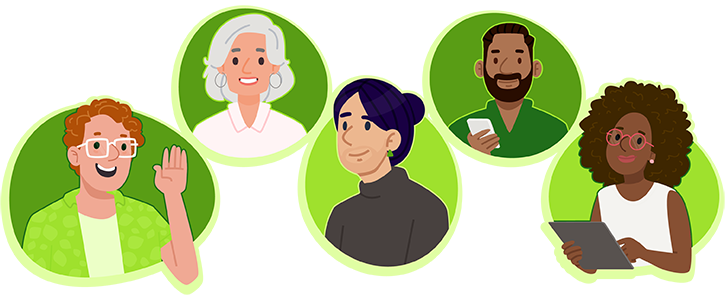Pronouns in the Workplace: How to Build an Inclusive Culture

Creating an inclusive employee community is a multifaceted effort. One crucial (yet simple) way to respect every person's identity is by intentionally providing the space to share their pronouns. After all, your employees are people with their own identities and they should feel a sense of belonging among their fellow teammates.
By starting the conversation, HR can build a diverse and equitable culture that fosters meaningful relationships between coworkers, allows team members to bring their authentic selves to work, and helps companies communicate that they genuinely care about their employees as humans—not just business units.
In this article, we'll discuss commonly used pronouns and how organizations, HR managers, and colleagues can encourage proper usage in the workplace.
What Are Pronouns?
Pronouns are the words we use to refer to people when not using their proper name (e.g., she/her/hers, he/him/his, they/them/theirs). It’s important to give people the opportunity to state which pronouns are correct to use when speaking to or about them.
What Are Nonbinary Pronouns?
Nonbinary pronouns are pronouns that aren't gender specific—they're used by people who identify outside of the male-female gender binary.
For example, individuals who use nonbinary pronouns may be one of many gender identities, such as:
- Genderqueer: They identify as neither exclusively male nor female, as somewhere in between or beyond genders, or as a combination of genders.
- Gender fluid: Their gender expression and/or gender identity changes over time.
The most common set of nonbinary pronouns to use when referring to a single person is they/them/their. While some argue that using these pronouns to refer to nonbinary individuals is grammatically incorrect, the singular “they” has been consistently used in English writing since the late 1300s. Plus, most people use the singular “they” in casual conversation.
Moreover, many cultures around the world have inclusive language for gender identities beyond the male-female classification. For example, the term two-spirit in many Native American tribes refers to individuals who have a combination of male and female qualities and have unique social or spiritual roles, such as healers and ceremonial leaders.
Why Pronouns at Work Matter
Simply put, using correct pronouns is about basic respect and treating others the way we would like to be treated. Just like how we ask for people’s names so we can refer to them correctly, using accurate pronouns honors people as individuals and affirms their identity.
Employees can’t be productive and present in the workplace if they feel ignored and disrespected. Sharing, asking, and using correct pronouns helps cultivate an empathetic and inclusive company culture in which colleagues can trust each other and work toward shared goals.
How to Share Pronouns in the Workplace
Sometimes it’s hard to start a conversation about pronouns, especially at work where it’s difficult to know when to introduce personal details into a professional dialogue. By giving all employees a safe space to communicate this information, the uncertainty dissipates, the conversation can happen more naturally, and the responsibility is shared by the entire workplace community (instead of being limited to specific individuals).
If you’re not sure where to start, consider inviting all employees to share their pronouns in their instant messaging profiles (e.g., Slack or Teams), email signatures, and employee directory information. You can also take the lead when meeting new colleagues by stating your pronouns proactively, making it easier for them to reciprocate. For example, “Hi, my name is Blake and my pronouns are she/her/hers. What pronouns do you use?”
Individuals who are new to these conversations may feel a bit awkward at first, but it can help everyone avoid making hurtful assumptions based on appearance and unintentionally misgendering someone in person or across platforms.
List of Pronouns: 45 Variations to Know
The list below is a helpful starting point in understanding pronoun diversity. It’s important to note that this list is not exhaustive and any combination is possible.
Source: Lesbian, Gay, Bisexual, Transgender, Queer, Intersex, Asexual (LGBTQIA+) Resource Center at UC Davis
Pronoun Examples in Action
Here are a few examples of how pronouns might appear in everyday workplace conversation.
He/Him Pronouns
Taylor prefers he/him pronouns:
- “Did you catch Taylor’s onboarding presentation today? He did great!”
- “The new hires are quickly learning the ropes by shadowing him.”
They/Them Pronouns
Sam prefers they/them pronouns:
- “Loop Sam in on the main topics—they volunteered to write the final video script.”
- “The campaign launch went smoothly, thanks in large part to them.”
She/They Pronouns
Some employees might use a blend of pronouns. In this case, it's always best to defer to your employee's personal choice:
- "Invite Alex to the meeting—she has great insight that the team would benefit from hearing."
- "Is Alex here yet? I hope they didn't get stuck in traffic."
Practice Makes Perfect
It's everyone's responsibility to learn other people’s pronouns (just as we all make the effort to know other people's names). But even with the best of intentions, mistakes can happen.
If you accidentally refer to someone using incorrect pronouns, your gut reaction may be to profusely apologize for the error. However, this can make the person who was misgendered feel uncomfortable. Instead, simply apologize, correct yourself right away, and carry on. Just be sure to strive to get it right next time.
Included. Supported. Retained.
Don't leave your company culture to chance. With accurate, reliable employee surveys in BambooHR, you'll gain the insight you need to prevent burnout, improve morale, and stop premature turnover in its tracks.